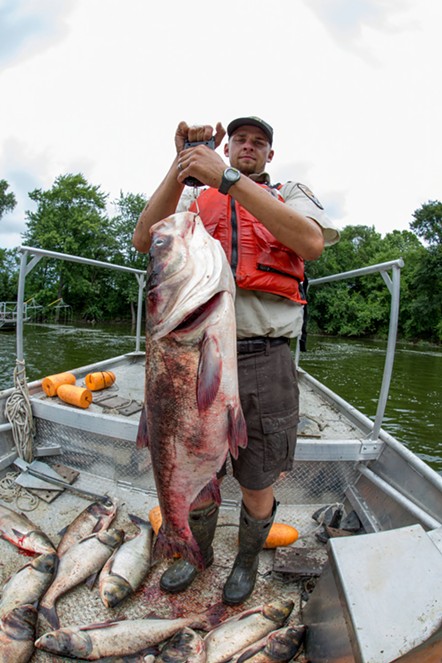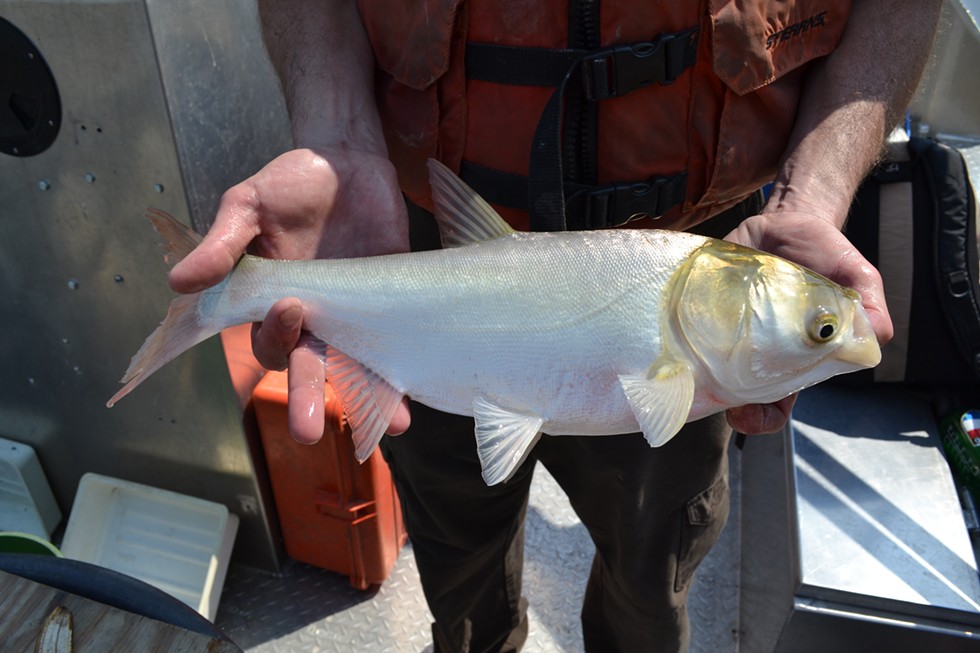Ships sailing up the St. Lawrence Seaway have dumped dozens of exotic critters into the Great Lakes since it opened more than a half century ago. The Chicago canal system turned this regional problem into an ever-growing national one as invasive species ride its waters out of the Great Lakes and into the basin that connects the waters of 31 states.
Scientists have identified 39 invasive species poised to ride the Chicago canal into or out of the Great Lakes, including a fish-killing virus in Lake Michigan today that could ravage the South's catfish farming industry as well as five species of nuisance fish, including the sea lamprey. Threatening from the other direction, beyond the Asian carp, is the razor-toothed snakehead, which can breathe air and slither short distances over land and is now swimming loose in the Mississippi basin. This problem was recognized nearly two decades ago, when Congress, alerted to the idea that Great Lakes invaders were primed to make their way out of the lakes and into the Mississippi basin, authorized construction of an experimental electrical barrier on the canal, about 35 miles downstream from Chicago's Lake Michigan shoreline.
Underwater electric barriers to block migrating fish had been successful on streams and irrigation canals in the West, but never on a waterway as big as Chicago's, and never on one that is a major navigation corridor plied by thousands of barges annually. After six years of designing, building, and debugging, the Army Corps finally turned on the $1.5 million contraption in 2002. But by then the species of Great Lakes invasive fish that scientists had feared would use the canal to escape into the Mississippi basin had already done so. So the barrier was repurposed as a device to halt the migration of Asian carp into the lakes from the other direction.
The barrier was always intended to be just a Band-Aid until a more permanent solution could be devised. But soon after it was activated, Congress became convinced it was worth funding a giant version, one built to last decades and operate at four times the strength of the original. Construction started in 2004 and was finished in 2006. But then the government refused to turn it on, largely because of the U.S. Coast Guard's fear that its electrical current would cause sparks to fly between canal barges, some of which carry petroleum and other flammable materials. The Coast Guard's primary mission, after all, is to protect the barge workers and recreational boaters floating up and down the canal. It's not to worry about what type of fish are swimming in the Great Lakes, even if it's a type of fish that some fret could utterly upend the world's largest freshwater system. As the former chairman of the commission that helps guide U.S. and Canadian management of the Great Lakes has put it: If the fight to stop the giant fish from colonizing the lakes fails, well, "it is just a matter of time before we end up with a carp pond."
Barrier safety tests dragged on into early 2008 when Army Corps Gen. John Peabody arrived to take charge of the carp fight. Peabody is a 1980 graduate of West Point who has done tours in the Pacific, Panama, Somalia, and the Middle East, where he led 3,000 engineers into Iraq during the 2003 attack on Baghdad. In his three-plus decades in uniform, Peabody has picked up a graduate degree in public administration from Harvard, studied as an Olmsted Scholar in Mexico City, and earned his master parachutist badge. He has received a Bronze Star for valor as well as a Purple Heart. The general limps on a metal hip. He has a penchant for quoting war movie dialogue and commands most any room he walks into with a no-nonsense demeanor that borders on brusque.
But he was also once a little boy who relished hot summer days at Lake Erie's Nickel Plate Park beach in Huron, Ohio. "The night before, we'd get picnic baskets, beach balls, all the rest, in our station wagon — this was the '60s...and my brothers and I would get all excited: 'Daddy, Daddy! Mommy's taking us to the lake!'" the general told me, as he knocked back a late afternoon coffee at the massive conference table in his office in downtown Vicksburg, Mississippi. "And my cynical dad would say: 'Your mother is taking you to the biggest cesspool in northern Ohio.'"
Despite the stench of all the rotting alewife carcasses littering the polluted beach when he was a child — one of which Peabody vividly recalls gouging his foot — the Great Lakes stole a soft spot in the heart of the hard-nosed general that motivated him when he took over the carp fight. "There was an opportunity for us to prevent a really bad thing from happening — a calamity, a crisis, whatever word you want to put to that."
In the months after he took over the job, Peabody turned on the new electric barrier that the Coast Guard had kept mothballed. As a safety compromise with his sister agency, Peabody ordered the new barrier, which was designed to run as high as four volts per inch, to run only at the same voltage as the nearby demonstration barrier: one volt per inch. One volt does not provide a strong enough jolt to stop juvenile fish, which, because of their size, are more immune to electrical pulses. But one volt was a level the barge industry could live with and, at the time, no Asian carp had been detected near the barrier.
"If the fish weren't close enough to be a threat, it didn't seem prudent at that time to raise the operating parameters," Peabody told me. That was a big if, and the general knew it. Biologists tracking the pace of the Asian carp's migration up the Mississippi and Illinois Rivers believed that by 2008 the fish should have long ago been probing the barrier, even though crews using nets and electroshocking devices continued to turn up zero evidence of fish in the area. Everyone involved knew that finding the first few fish at the leading edge of the invasion would be exceedingly difficult because the fish have an uncanny ability to avoid nets. Shocking the water to stun the fish so they float to the surface doesn't work either, because Asian carp can often lurk too deep to be stunned.
Even though the nets used to hunt the carp near the barrier came up empty, Peabody still smelled trouble in the canal. "Our lack of information was so great," he told me. "I felt we had to take whatever we could and apply it as quickly as possible to try and get more information."
The University of Notre Dame's David Lodge had what he was looking for.
Lodge's skills as an ecologist and his willingness to wade into sticky issues had made him and his colleagues a logical choice a few years earlier when a think tank funded by the Great Lakes states gave his lab a grant to develop a genetic-based test to identify invasive species hitchhiking into the lakes in the ballast water of Seaway freighters. Law enforcement investigators have been using DNA analysis for more than two decades to put criminals behind bars. These genetic fingerprints can be harvested from almost anything the human body sheds — flecks of skin, strings of saliva, drops of semen, strands of hair. From that material, scientists can isolate and identify the molecules that are an individual's DNA, the famous double helix. Each minuscule twisting ladder is made up of billions of rungs built from four types of chemicals, called nucleotides. DNA is such a powerful forensic tool because the order of these billions of rungs, each made up of two interlocking nucleotides, is unique for each individual. Scientists zero in on relatively short sequences of nucleotides on a piece of human DNA to see if the genetic material harvested from a crime scene is a match for DNA taken from a suspect.
But this genetic fingerprinting process also works on the species level; all silver carp, for example, share an identical sequence of nucleotides at various places in their DNA. It wasn't a big leap for the Notre Dame team to realize that DNA testing could be used to find evidence of carp in the canal. This kind of analysis had already been done on a smaller scale by an Italian researcher who used traces of DNA to find American bullfrogs in European ponds. It works because fish and other aquatic life constantly shed cells in mucus, urine, and feces. Those cells tend to stay suspended in water, and that means every fish leaves in its wake a genetic trail. That trail can be traced by filtering all the DNA from all the different species that have left behind a piece of themselves in a water sample.
Once that pile of DNA is isolated, lab technicians put it in a test tube and add to it some precisely engineered genetic markers — called primers — that are designed to attach only to the DNA of the targeted species. A concoction with free-floating nucleotides is also added to the mix and then the sample is heated. The heat unravels the DNA helixes of all the species filtered from the original water sample. If any of the targeted species' DNA is present, the primers glom on to each separated helix as the sample cools. That starts a zipper-like reaction in which an enzyme that is added to the sample binds the free-floating nucleotides to each strand of original DNA. Suddenly one piece of DNA has been turned into two. The process is repeated over and over so that even a single piece of DNA can be replicated beyond a billion, to the point the target DNA can actually be seen as a glow under an ultraviolet light when yet another chemical is added. One piece of DNA wouldn't be enough to identify a species in a sample, nor would 100,000. But once you get a billion or beyond, a visible glow emerges.
Now a previously invisible fish is revealed.
It all worked beautifully in the Notre Dame lab, but Lodge's team knew there was a big difference between isolating DNA floating in aquariums and sifting it from a free-flowing river. By early 2009, Lodge's staff was ready to try. At a January meeting in downtown Chicago among researchers guiding operation of the Army Corps' electric fish barrier, one of Lodge's assistants pulled an Army Corps biologist into a quiet corner. He told her he believed they had cracked the problem of filtering and identifying Asian carp DNA from open water and he thought it could be applied on the Chicago canal. The biologist took the idea to her bosses at the Army Corps' regional office in Chicago and got the go-ahead. At that time, Peabody had no idea what his staff or the Notre Dame scientists were up to.
Andy Mahon, an ecologist and geneticist who worked in Lodge's lab back then, remembers the miserable morning a few months later when he and a colleague gave their new fish-hunting tool a whirl on the muddy, spring-swollen Illinois River. They figured if DNA didn't turn up in a place like this, known to be thick with Asian carp, there was no sense trying to detect it where there might be only a handful of the fish. The two spent the morning freezing their hands filling two-liter plastic bottles, the excitement they had felt just weeks earlier in the lab tumbling away as they worked. How could they possibly find mere molecules of fish in all this murky water? Mahon headed back to South Bend with his spirit as chilled as the bones in his fingers. He was alone in his lab testing the samples a few days later when the telltale glow emerged. He dashed down the hallway looking for Lodge and the others.
"Shocked," is how he described their collective reaction.
The team decided to move the testing slowly up the river, toward areas where carp numbers were known to be lower. "We had developed the tool and tested it the best way we could — in the lab, and in the field in a preliminary way," Lodge said. "But to build our own confidence and build the confidence of anybody else, we wanted to start in places where everybody agreed there were fish. So the general strategy was to start south and work our way north [toward the barrier], because the whole idea was to identify where the leading edge of the invasion front was."
When Peabody finally got word of what the Notre Dame scientists were up to, he requested a face-to-face meeting. In the summer of 2009, the general and his staff showed up at Rosie's Family Restaurant just down the road from the electric fish barrier in an industrial corner of suburban southwest Chicago. Peabody and his staff, as usual, arrived in combat dress — camouflaged pants tucked into high-laced boots — to grill one of Lodge's colleagues on what the Notre Dame team was trying to do.
Peabody planted himself at the head of a table with the Notre Dame scientist at his side (Lodge was not there that day; he had a class to teach). The general's staff scattered around, some standing, some sitting at the table. A map was unfolded. Sugar packets were used to represent fish, barriers, and boats. It was at times an awkward summit between military men who were demanding clear, yes-or-no answers and a scientist who makes his living in the fuzzy place at the edge of human knowledge.
Lodge's crew knew it was wading into murky waters. For one thing, the specific technique it developed to hunt for Asian carp in rivers hadn't at that point been published in a scientific journal, which meant it had not been independently validated by other scientists. What's more, this type of DNA analysis can indicate nothing about numbers of fish, their precise location (DNA drifts on the current), exactly how long that genetic material has been in the river or even how it might have gotten there. But Peabody was determined to find out if the fish were pressing up against the new barrier. If the general could demonstrate that the giant carp (or even their tiny offspring) had indeed arrived at the barrier, that could justify cranking up its voltage. Peabody heard enough that day to be convinced DNA was the best tool he had to find the fish. He allowed Lodge's team to press on.
The Great Lakes’ last line of defense against an Asian carp invasion had apparently failed.
tweet this
The Notre Dame team continued northward in its testing — and continued to turn up evidence of the fish. In September 2009, it reported Asian carp DNA about 10 miles farther upriver than the fish had ever been seen. If the DNA evidence was correct, Asian carp had passed through the last navigation lock before the electric barrier. A lock is a relatively tricky obstacle for a group of fish trying to colonize new waters because a fish has to accompany a boat into the lock chamber and exit with it once the boat is lifted and the lock gates are opened. Think of a cockroach using an elevator to migrate between floors of an office building. It probably will happen eventually, but it involves a certain amount of luck. Then, to establish a breeding population, others have to make the same trip. Then they have to find each other.
The general might not have been pleased with fresh intelligence that at least one fish had apparently breached the last lock before the electric barrier. But at least this new DNA tool seemed to work precisely the way he had hoped. Like a pair of night-vision goggles, it illuminated a previously invisible enemy, and that gave the general a chance to fight back. Peabody doubled the barrier voltage.
The Notre Dame team pressed on with its sampling. Lodge didn't plan to stop until he got to an area of the river where all sampling showed no trace of DNA. "The whole point," he said, "is to go to where we got all zeros, and of course, everybody, including us, was hoping all zeros happened below the barrier."
Everything changed on Nov. 18, 2009, at 7:48 a.m. That's when Lodge sent an email notifying Army Corps officials that water samples beyond the barrier had tested positive for Asian carp. This was not a memo Lodge wanted to write. When it was time to hit the send button, he said, "It made me feel a little sick."
Lodge reckoned a positive sample above the barrier meant at least some Asian carp had somehow gotten through. Like everything else, DNA can't drift upstream. Environmental groups and politicians from neighboring Great Lakes states pounced at the news that the Great Lakes' last line of defense against an Asian carp invasion had apparently failed. They demanded that the Army Corps stop operating two navigation locks near downtown Chicago. The idea was to use the locks as makeshift dams to block the carp's final advance into Lake Michigan. The problem is that closing the gates would not just stop fish, it would also stop the free flow of cargo on the canal, a move that Illinois barge operators said would have disastrous consequences not only for their businesses but for the industries they serve, as well as the fleet of recreational and tour boats in downtown Chicago. But just as it is dubious that closing the St. Lawrence Seaway to overseas traffic would have devastating international economic consequences, the financial impact of shutting the locks (which would affect less than 1 percent of the total cargo moved through the Chicago region daily) was probably overblown by the barge industry.
Even so, Peabody, who is in the business of moving barges, wasn't about to recommend lock closure, which he argued wouldn't necessarily work because the structures are aged and leaky and the fish might pass through in any event. The locks would also have to be opened if big rains hit because when the water level gets exceptionally high in the Chicago canal, the whole system reverses and the Chicago River temporarily flows backward into Lake Michigan. Not opening the locks to allow this to happen could inundate downtown Chicago.
In any case, Peabody clearly felt he was already doing enough. He'd cranked up the voltage at the barrier and, just days before he learned that Asian carp DNA had been found beyond it, his agency backed a most radical plan to literally stop dead any migrating fish.








